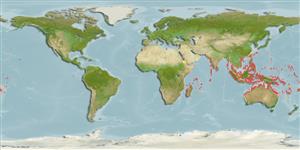Common names from other countries
Environment: milieu / climate zone / depth range / distribution range
экология
ассоциированный с рифами; пределы глубины 2 - 20 m (Ref. 98471). Tropical; 28°N - 34°S, 27°E - 170°W (Ref. 846)
Indo-Pacific. Tropical to subtropical.
Length at first maturity / Size / Вес / Возраст
Maturity: Lm ? range ? - ? cmCommon length : 9.9 cm DL самец/пол неопределен; (Ref. 269)
Colonies are formed of thick encrustations that develop atout (usually less than 10 cm in diameter), vertical, irregulary shaped branches, depending on exposure to wave action. May dominate wave-washed communities due to its solid construction. Axial corallites are difficult to distinguish due to the large area of branch tip. Many colonies consist of less than 12 main branches (Ref. 269).
Usually less than 10 cm. Common in shallow and intermediate depths (Ref. 269). Occurs subtidally on deeper areas of reef flat, edge, slope, walls and submerged reefs (Ref. 98471).
Life cycle and mating behavior
половая зрелость | размножение | нерест | икра | Fecundity | личинки
Hermaphroditic (Ref. 113712). Mature gametes are shed into the coelenteron and spawned through the mouth. Life cycle: The zygote develops into a planktonic planula larva. Metamorphosis begins with early morphogenesis of tentacles, septa and pharynx before larval settlement on the aboral end (Ref. 833).
Основная ссылка
ссылки | координатор | соавторы
Hodgson, G. 1998. (Ref. 269)
Статус Красного Списка МСОП (Ref. 130435)
Статус СИТЕС (Ref. 108899)
Not Evaluated
Использование человеком
| FishSource |
инструменты
дополнительная информация
Возраст/РазмерыростЗависимость между длиной и массой телаЗависимость между длинамиморфологияличинкичисленность
ресурсы в Интернет
Estimates based on models
Preferred temperature
(Ref.
115969): 24.7 - 29.3, mean 28.5 (based on 3296 cells).
Категория цены
Unknown.
